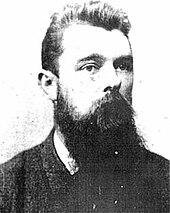Pedersen (bicycle)
The Pedersen is a bicycle developed around 1890 by the Dane Mikael Pedersen (1855–1929) , for which a patent was applied for on September 30, 1893 in Great Britain . The German patent dates from March 20, 1894.
Mikael Pedersen was not satisfied with the comfort of the bicycles of the time and therefore developed his own braided saddle that was hung up like a hammock. Around this saddle, which swings sideways, he built the frame only from triangles. With minimal weight, it achieved extremely high stability. The bracing from the saddle to the rear dropout is now done by means of a wire rope, long spokes were used for this in the past. Mikael Pedersen built a Pedersen with a weight of 5.1 kg as early as the beginning of the 20th century. Since the wheels were manufactured from 1893 to around 1920 in Mikael Pedersen's home town of Dursley ( Gloucestershire , England ), they are also called Dursley-Pedersens .
The manufacture of such a frame is, due to the many soldering points, considerably more complex than with a conventional bicycle, as is the special saddle (today made of leather). This is why Pedersens were and are usually more expensive than conventional bicycles. The Pedersen bikes have been reproduced again since the early 1980s. The blacksmith Jesper Sölling in Christiania , who now lives in Ebeltoft (Denmark) , began to build bicycles in the mid-1980s, Michael Kemper Pedersen bicycles , his manufacture is now in Erkelenz- Grambusch (Heinsberg district). Pedersen bikes are usually manufactured individually according to customer requirements. There are many different sizes, from small children's Pedersen with 20 ″ tires to oversized ones. There are also Pedersen tandems or trridems.
gallery
Web links
- Picture of an original saddle
- The Pedersen Bicycle, history. Retrieved April 4, 2017 .




